Apple touts that there are now over 500 car models supporting CarPlay, and Nissan's luxury brand Infiniti is one of the most recent (and perhaps the last significant brand in the U.S. other than Tesla) to add the feature with the 2020 Q50 and Q60 sedans, QX50 crossover, and QX80 SUV.
I've had an opportunity to spend some time with a 2020 Infiniti QX50 and check out how the updated InTouch infotainment system and CarPlay work with the dual screens dominating the center of the dashboard, and I've come away fairly impressed with the performance and ease of use.

The 2020 QX50 comes in five trim levels starting at $37,250 for the base Pure trim and topping out at a little over $60,000 for a fully loaded Autograph trim. All trims are available with either front-wheel drive or all-wheel drive, with the latter costing an extra $2,000. CarPlay and Android Auto are standard on all trims, and dual center touchscreens with an 8-inch display on top and a 7-inch display on the bottom are uniform throughout the lineup.
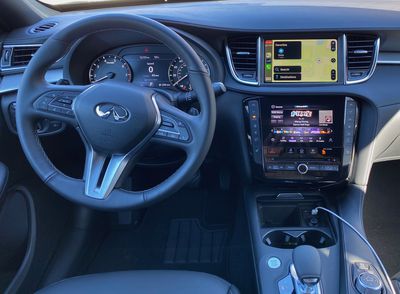
My test vehicle was an all-wheel drive Essential trim, which is the middle of the five available trims, and it came with a $1,200 "Edition 30" appearance package that also bundles in the ProASSIST features such as distance control, intelligent control, blind spot monitoring, lane departure prevention, and adaptive front lighting. Toss in upgraded Majestic White paint and some welcome lighting and cargo packages, and my tester checked in at just under $50,000.
InTouch Hardware and Software
Infiniti is certainly not the only manufacturer to pursue a dual-display infotainment solution, and I've had some previous experience with such a system in the Audi A7. Part of what sets Infiniti apart here, however, is that hardware buttons were thankfully not sacrificed in favor of all-screen controls. The lower screen of the InTouch system is surrounded by hardware controls, including climate controls along the left and right sides and some hardware audio buttons and a knob along the bottom just below the CD drive.
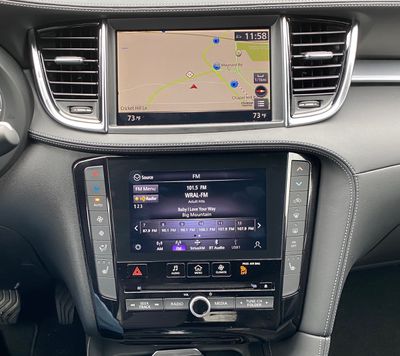
There are also some quick-access hardware buttons for jumping between the main InTouch home screen, the audio screen, and the climate screen where only a few digital adjustments like manual fan speed can be made, but almost all of these are also accessible through the hardware buttons on either side of the screen. Add in the usual bevy of steering wheel controls, and you can accomplish a heck of a lot just by feel, which is fantastic.
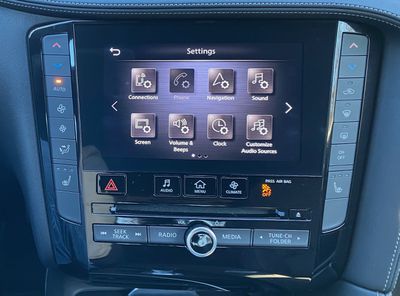
The upper screen is largely dedicated to the built-in navigation that's standard on Essential and higher trims and optional on the second-level Luxe trim, and this is also where CarPlay shows up. Even here, Infiniti provides options for interacting with the content, supporting both touch directly on the screen and indirect control via a knob and a few buttons on the center console. I generally prefer using touch or voice for interacting with CarPlay and built-in navigation systems, but it's nice to have another indirect method available for quick adjustment or for those who prefer it on a more regular basis.
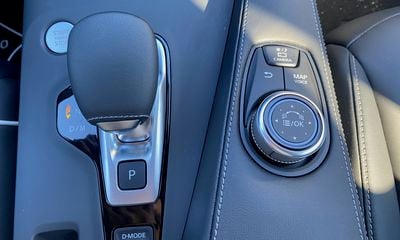
Infiniti's InTouch software bears some distinct similarities to the NissanConnect infotainment system of the brand's parent company, which I previously looked at in the Leaf and Altima, but it's been augmented with some higher-end features and of course optimized for the dual-display setup.
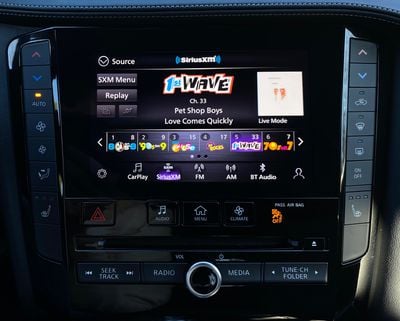
The audio setup is very similar to the NissanConnect system I've used in other vehicles, with a relatively straightforward layout and a customizable bottom menu bar to set up and quickly access your preferred audio sources. SiriusXM content in particular looks good with colorful channel logos and album art visible on the screen. The interface for terrestrial radio stations is a bit simpler, but still offers a clean look with station and song information when available and support for HD radio.
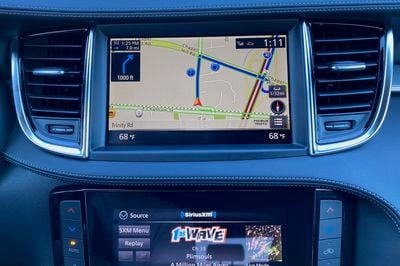
The onboard navigation works well with 3D city views, lane guidance, exit signs, and a variety of available views to customize the navigation experience, although the overall look could stand to see some modernization. There's support for street and satellite views, real-time traffic, and Destinations by Google, which offers an improved POI search experience compared to the embedded system's database. Over-the-air map updates are also available. The overall look of the maps isn't as modern as what you see with Apple or Google Maps, for example, but functionally it's a pretty solid system. Of course, with CarPlay and Android Auto, you may not even want to use the onboard navigation, but it's there if you want or need it.
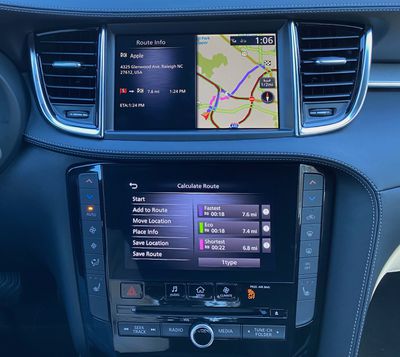
In addition to the dual displays in the center stack, there's also a digital display for the driver between a pair of analog gauges. The display offers a number of different views including speed, audio information, navigation, ProPILOT Assist driver assistance features, and more, so that can serve to augment the at-a-glance availability of information from the various vehicle systems. A head-up display is also available standard on the top-end Autograph trim and as part of a package option on the step-down Sensory trim.
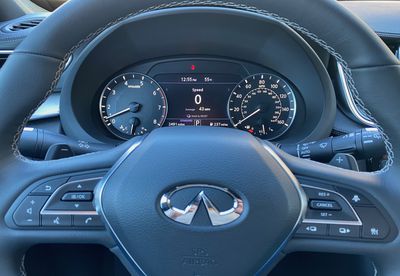
The QX50 includes the usual array of steering wheel controls for accessing functions like volume, cruise control, phone calls, and more, and the dedicated voice control button serves dual duty with a short press activating the InTouch voice system and a long press bringing up Siri for either Siri Eyes Free or CarPlay.
CarPlay
CarPlay on the 2020 QX50 does require a wired connection, which is a little unfortunate at a time when more and more luxury brands including Audi, BMW, and Porsche are supporting wireless CarPlay and it's on the verge of rolling out to more mainstream brands from the likes of Ford, GM, and Fiat Chrysler. Infiniti does tell me that wireless CarPlay is coming in the "near future," but it would have been nice to see it from the very start.
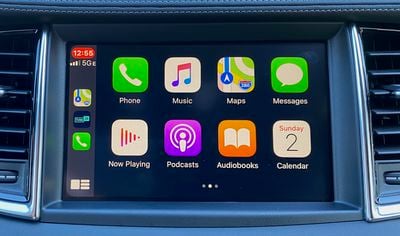
Setting the lack of wireless support aside, CarPlay works quite well on the dual-screen InTouch system, and it's great being able to dedicate the top display to CarPlay while native functions like audio and other features remain fully visible and accessible on the lower display. The 8-inch top screen provides ample room for the CarPlay interface, and everything looks big and bright sitting fairly high on the dashboard so it's not too far out of the driver's line of sight.
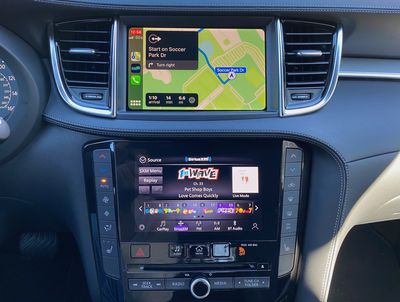
I had no problems reaching all parts of the screen to manipulate CarPlay by touch, or you can use the control knob on the center console to scroll through the various interface elements and select the one you want.
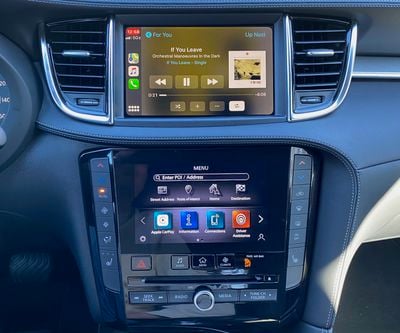
The flexibility of having dual displays and the redundancy of many of the native system functions between them really lets CarPlay shine, as you really don't have to worry about switching away from it to access the Infiniti system. Some adjustments will trigger a brief overlay on the CarPlay screen, but other than that you're free to tweak audio, climate, and vehicle settings without disrupting the CarPlay experience.
Ports and Connectivity
All QX50 trims come equipped with four USB ports, highlighted by one USB-C and one USB-A at the front of the center console next to the cupholders, and both ports support data connections for CarPlay. The other two ports are charge-only USB-A ports, with one located inside the center console compartment and one on the rear of the console to provide power for backseat passengers.
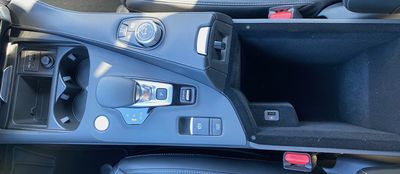
One downside is the lack of a good place for phone storage, as there is little space near the front USB ports other than a pair of cupholders and a small storage tray that isn't big enough to fit a phone without obstructing at least one of the cupholders. Storing your phone in the center console compartment is also an option, but it requires more effort to get in and out of the compartment and involves running the USB cable into the compartment, so it at least would have been nice if the USB port inside that compartment supported data transfer so everything could be tucked away inside. Wireless phone charging is not available on any QX50 trims.
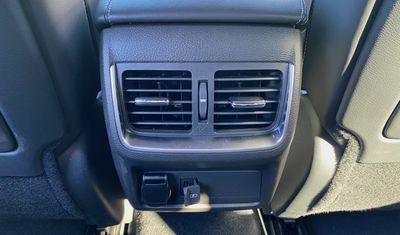
Vehicles equipped with onboard navigation do include Wi-Fi hotspot functionality for up to seven devices, letting your passengers connect to the Internet with a data plan from AT&T.
Wrap-up
Infiniti may have been late to the CarPlay game, but it's come through in a solid way in the 2020 QX50, and also the Q50, Q60, and QX80, which all have nearly identical layouts with dual displays and a host of hardware controls. Infiniti has done a good job of building on the bones of the NissanConnect infotainment to take it to the next level, and iPhone users will be pleased at the prominence CarPlay receives on the dashboard.
The flexibility of the new InTouch system that lets you interact with the system in the way you prefer is fantastic, giving you the choice of touchscreen, hardware buttons, voice, and even a control knob. I also like that there's a bit of future-proofing for the primary USB ports up front, with one USB-C and one USB-A.
There are always a few nits to pick, however, and phone storage in the QX50 is one for me. There's no great place to put your phone while it's plugged in, and the USB port inside the center console compartment can't be used for CarPlay. And with wireless CarPlay quickly becoming more common, particularly on luxury brands, it would have been nice to see that included here, but hopefully Infiniti will follow through and make that upgrade soon.
The QX50 is of course a luxury brand, so it has a bit of price tag starting in the mid to high $30K range, roughly on par with the Acura RDX that I took a look at a little over a year ago, but a decent amount less than other small luxury crossovers it aims to compete against like the Audi Q5 and the BMW X3. With five available trims, there's a range of price points that can push things to nearly $50,000, but the good news for iPhone users is that CarPlay is standard on all trims, so you won't need to jump up a level or two or add an option package to get it.
























Top Rated Comments
After a decade of trying, Infiniti pulled out of Europe last year due to dismal sales. Its contemporary, Lexus. remains in the market as a bit player, but at least their sales are trending up.
Subjectively, Infiniti was going to be Japan's "BMW" vs. Lexus' "Mercedes" when they were both launched.
Back then, Nissan was an engineering-driven company, and the first Q45 was a great piece of engineering and a credible challenger to the 7-series, while the Lexus LS was clearly gunning for the S-class.
Up and down the line, from the Sentra, 240SX, 300Z, Maxima, Nissan packed their product with advanced engineering that help set them apart in their classes. The SE-R was a hidden gem, with the SR20DE, limited slip, fully-independent suspension. The G20 took that drivetrain and put it in a Euro-targeted sedan with a multi-link front suspension.
Unfortunately, that didn't lead to success, and the products became progressively less advanced. When it descended into crisis, Ghosn was brought in to save the company, with heavy cuts and upending the status quo.
While that brought about a recovery, it also resulted in product that was dumbed-down, cost-driven, and ultimately uninspiring.
That's pretty much the theme Nissan as a whole has ridden for years. The latest soap opera has added some excitement to the company, but that's not reflective of the product.
Ultimately, those big dreams of joining the club with the Germans really only worked out for Lexus. Acura can claim it wasn't as serious of a push upscale, but it, too has flailed for years. Volvo tried to move upmarket and failed. Amati, Mazda's effort, was killed before it even launched.
In that time, Audi has solidified its position to make it a German trio, and can arguably make a case that it belongs in Tier 1 with Merceds, BMW, and Lexus. Cadillac, Lincoln, Acura and Infiniti are stuck in Tier 2.
And after a slow start, with the Koreans ramping up their efforts in that space, things won't get any easier as their product improves even more. The T1 established marques will weather that better than the T2 strugglers.
Here's another hint -- marques that have clear visions and have success don't move their HQs in some fruitless search to find themselves, or satisfy the whims of their executives. Two on that T2 list have, Infiniti being one of them.
The subject of this story is a good illustration. For a luxury marque to only now be joining the CarPlay club is almost inexcusable.
No one is “buying” a car with the hopes of making a profit at the end of its life. Cars are depreciating asset. You don’t purchase a car as an investment. It’s a luxury item.
Never be able to “Sell” the car. Someone would by a 2020 car in 2026 for $500 I guarantee it. That’s me “selling” it.